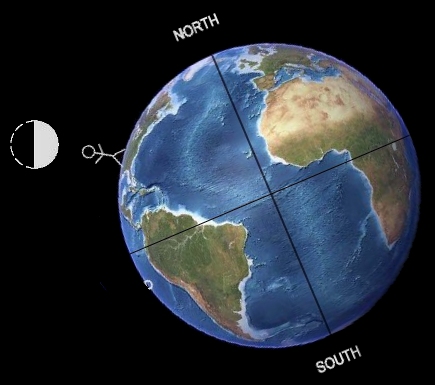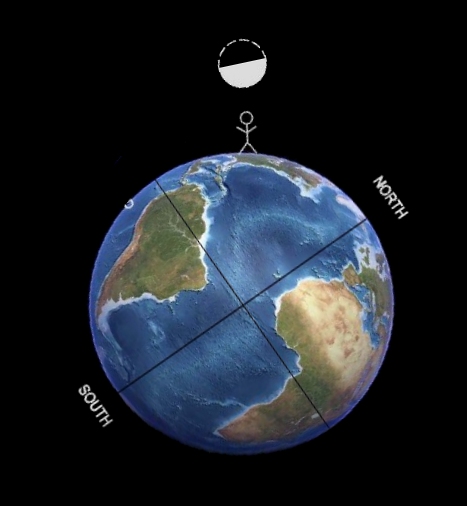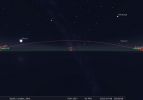It looks like you're using an Ad Blocker.
Please white-list or disable AboveTopSecret.com in your ad-blocking tool.
Thank you.
Some features of ATS will be disabled while you continue to use an ad-blocker.
share:
Originally posted by justme2112
So now am I the troll? interesting...
I told you: DID YOU EVER OPEN A SINGLE BOOK and then saw a single image of a sideway moon relative to northern hemisphere?

Originally posted by justme2112
Me wrong? pfff
Anyway for books a mean SCHOOL BOOKS so NOT in **** amatour magazines and probably you did not give the right interpretation for that image for sure (if its really was there).
However what are you?edit on 17-12-2012 by justme2112 because: some eng. fix. eng its not my 1st language.

Originally posted by justme2112
Originally posted by ngchunter
On Friday I will go to a school library and photograph or scan a page of a book that contains one of these photographs.
I'll even tell you which school; University of Florida.edit on 17-12-2012 by ngchunter because: (no reason given)
You'll waste your time, there are not such a single image / explanation relative to the northern hemisphere about the sideaway moon at all. And the reason its not, is pretty obvious.

reply to post by ngchunter

Originally posted by Terims
Can anyone supply me with an answer that makes sense. The only thing I could think of is that either the moon or earth has changed it's orbit. Maybe we already had a temporary pole shift, eh? It's back to normal these days but every once in a while you will see it tipped again.
Namaste
See the posts above yours, with pictures. The apparent tilting of the Moon is due to the Earth's axial tilt making different angles with the Moon's orbit in summer and winter. It's nothing new, and nothing to be concerned about.
P.S. I took the pictures posted earlier by Soylent Green Is People and adjusted them for the Earth's axial tilt in winter. The Northern Hemisphere points away from the Sun and towards the Moon in the night sky.

Rotated to show the person's point of view:

edit on 17-12-2012 by wildespace because: (no reason given)
As promised, straight from the university of Florida library:
Originally posted by justme2112
Originally posted by luxordelphi
reply to post by Illustronic
NASA provides data for people that want to use that for scientific calculations and experimentations. I doubt the really care if people run their lives on moon phases. How much sense does that make? I mean really.
NASA provides a child-like drawing on at least two of their websites in order to explain the boat moon. NASA claims that the moon is seasonal and has a winter and summer path and this, to NASA, explains the boat moon at locations far from the equator. That doesn't sound very scientific to me - it sounds like beetle dung.
So what can a person deduce about their calculations for public consumption based on this? They are going to be skewed in order to support the original 'what a tangled web we weave.' Say it ain't so.
I agree with you luxor, I have noticed the same moon in the last 3 years (started with minor freq. since 2007).
and this one is the moon in sideawy mode on a very high latitude in Canada, here's a video footage:
Something is goin on since almost 2007.
edit on 17-12-2012 by justme2112 because: (no reason given)edit on 17-12-2012 by justme2112 because: (no reason given)
I still remember the first time I saw it. It was in 2003 or 2004. Took me awhile to understand why it was so startling and even longer to come to terms with what that meant i.e. what could cause something like that.
The moon has been eerily bright lately, even when half full. Last night it was almost directly overhead from my mid-latitude location. Because it is so wierdly bright, it creates shadows. I didn't stay out until the moon reached its' highest point but even slightly off that highest point, my shadow, from the moon, was very very short.
Don't even know what to make of this phenomenon happening in Canada. Back in 2003 or 2004 when I first started to search on the net for other people who had seen this, I came across some sightings in Washington state. That's getting up there. It was some years later that this phenomenon happened in the UK. There were stories then about what the media decided to call the 'Cheshire Moon.' Bizarre.
The moon, sun, zodiac are directly overhead when viewed from the equator. In mid-latitudes, the moon, sun, zodiac are always 'over there' and not overhead. So that's an easy way to determine that things are seriously out of whack.
The sun is only directly overhead someone on the equator twice a year (the equinoxes).
Originally posted by luxordelphi
The moon, sun, zodiac are directly overhead when viewed from the equator.
Originally posted by nataylor
The sun is only directly overhead someone on the equator twice a year (the equinoxes).
Originally posted by luxordelphi
The moon, sun, zodiac are directly overhead when viewed from the equator.
Not only that, but during the solstices (one of which we just had), the equator is farther away from being directly under the Sun than -- say -- areas near the tropics *at about 23 degrees latitude.
There are some nights (depending on the position of the Moon in the sky relative to time of night) around the winter solstice that parts of the United States are MORE directly beneath the Moon than the equator is...
During the winter solstice, the equator may be 23 degrees away (south) from being directly under the Moon on some nights while some parts of the U.S. are only 20 degrees away (north) from being directly under the Moon on some nights.
reply to post by luxordelphi
See, you are completely ignoring the Earth's axial tilt and what this means for the ecliptic in winter and summer. It's very basic astronomy. In winter, the northern hemisphere points away from the Sun, so at night the ecliptic is higher above the horizon than in summer. This tilt makes the angle between the ecliptic and the horizon more vertical, which in turn makes the Moon tilted like that. This happens every winter; it's not new and there's nothing unusual about it. You can see this in Stellarium if you're familiar with using it. Or just look at the pictures I posted above.
The Moon can look brighter than usual when it's closer to Earth in its orbit, again nothing unusual.
P.S. I made some more images. The ecliptic as seen on summer nights, and winter nights:


The higher ecliptic means you can see Jupiter and the Moon very high in the sky.
See, you are completely ignoring the Earth's axial tilt and what this means for the ecliptic in winter and summer. It's very basic astronomy. In winter, the northern hemisphere points away from the Sun, so at night the ecliptic is higher above the horizon than in summer. This tilt makes the angle between the ecliptic and the horizon more vertical, which in turn makes the Moon tilted like that. This happens every winter; it's not new and there's nothing unusual about it. You can see this in Stellarium if you're familiar with using it. Or just look at the pictures I posted above.
The Moon can look brighter than usual when it's closer to Earth in its orbit, again nothing unusual.
P.S. I made some more images. The ecliptic as seen on summer nights, and winter nights:


The higher ecliptic means you can see Jupiter and the Moon very high in the sky.
edit on 27-12-2012 by wildespace because: (no reason given)
reply to post by nataylor
Deja vu to you, nataylor. Get yourself a globe, buddy, and you can see how far the ecliptic deviates from the equator. Or a star map will also show you that relationship. If your interest continues, you might check mid-latitude locations and come to an understanding of why there are mid-latitude locations as opposed to tropical and sub-tropical points. If your attention still holds, may I suggest looking at the yearly cycle of the sun and the 18.6 year cycle of the moon. And a comparison of those with the ecliptic mid-latidude and equatorial positions.
At that point, you would be ideally poised for a judgement of: things are out of whack. Or...you could just look up, from a mid-latitude location, and note whether or not the moon is directly overhead (as opposed to over there) because that is something that should never happen. Perhaps you could spot the Pleiades directly overhead from a mid-latitude location - also a no no. Or, even, an omg moment, the sun directly overhead from mid-latitudes.
Deja vu to you, nataylor. Get yourself a globe, buddy, and you can see how far the ecliptic deviates from the equator. Or a star map will also show you that relationship. If your interest continues, you might check mid-latitude locations and come to an understanding of why there are mid-latitude locations as opposed to tropical and sub-tropical points. If your attention still holds, may I suggest looking at the yearly cycle of the sun and the 18.6 year cycle of the moon. And a comparison of those with the ecliptic mid-latidude and equatorial positions.
At that point, you would be ideally poised for a judgement of: things are out of whack. Or...you could just look up, from a mid-latitude location, and note whether or not the moon is directly overhead (as opposed to over there) because that is something that should never happen. Perhaps you could spot the Pleiades directly overhead from a mid-latitude location - also a no no. Or, even, an omg moment, the sun directly overhead from mid-latitudes.
reply to post by luxordelphi
Depending on the time of the year, the sun will be directly overhead at least once a year to everyone as far north or south as 23.5°. Depending on the time of the moon's orbit, the moon will be directly overhead at some point in the 18.6 year lunar cycle to people as far north and south as 28.6°. Depending on the time of year, the Plaedies will be directly overhead at least once a year to people as far north or south as 48.2°.
Any farther north or south than 23.5° and the sun will never be directly overhead. Any farther than 28.6° and the moon will never be directly overhead. Any farther than 48.2° and the Plaedies will never be directly overhead.
Depending on the time of the year, the sun will be directly overhead at least once a year to everyone as far north or south as 23.5°. Depending on the time of the moon's orbit, the moon will be directly overhead at some point in the 18.6 year lunar cycle to people as far north and south as 28.6°. Depending on the time of year, the Plaedies will be directly overhead at least once a year to people as far north or south as 48.2°.
Any farther north or south than 23.5° and the sun will never be directly overhead. Any farther than 28.6° and the moon will never be directly overhead. Any farther than 48.2° and the Plaedies will never be directly overhead.
Originally posted by nataylor
Depending on the time of year, the Plaedies will be directly overhead at least once a year to people as far north or south as 48.2°.
.
.
.
Any farther than 48.2° and the Pleiades will never be directly overhead.
Nitpick: Since the Pleiades doesn't move around the ecliptic, it will pass directly overhead every day of the year, but only at ~48.2° North. It will not pass directly overhead for any other latitude (until precession takes its course).
However, when craning ones neck to look straight up, it is very difficult to gauge just how far off the zenith something is. Someone may swear that such-and-such is "straight up", but errors of greater than 10° are not uncommon. I would not trust any estimate that didn't involve a bubble leveled mount with a spotting scope and declination marked in degrees.
Otherwise, what you said was correct.
On a side note, I remembered reading Ann Rice's "Interview with a Vampire" in which two vampires are killed by placing them in a narrow, high-walled courtyard, so that when the sun was straight overhead at noon, the Nosferatu (with no shadow in which to hide) were destroyed. Clever, except that the scene was set in Paris, which is at 49° north latitude - The sun would never be less than 25° from straight overhead (and usually much more). Oh well; it was a book about frickin' vampires - it didn't need to be vetted by Carl Sagan.
Originally posted by luxordelphi
reply to post by nataylor
If your attention still holds, may I suggest looking at the yearly cycle of the sun and the 18.6 year cycle of the moon. And a comparison of those with the ecliptic mid-latidude and equatorial positions.
Funny, I just recently measured the sun's position and compared it to its predicted position on the ecliptic. Guess what? It's exactly where it should be. On December 19th, 2012 I recorded the sun shortly before sunset. At 4:27:00pm eastern time (21:27:00 UT), I disengaged the telescope's tracking system and allowed the earth's rotation to take over. Here's the image of the sun at the moment I disengaged the tracking:
i319.photobucket.com...
1 hr 47 min 35 sec later (at 6:14:35pm eastern time, 23:14:35 UT) these stars passed through the field of view:
i319.photobucket.com...
Overlaying these two images allowed me to compare the sun's detected position to its predicted position with Cartes du Ciel and indeed the sun is right where it should be:
i319.photobucket.com...
Here's the raw video of the whole thing:
Likewise I've observed the moon lately with my GOTO telescope and have found it to be right where it should be; if it weren't, my old telescope running software that's over a decade old would not have been able to find it. I've also directly measured its position before and could do so again if you'd like to see the results. On 10/2/11 I took a frame of the moon from this video (www.ustream.tv... ) right as I disengaged the drive system at 10:29:00 eastern time. I then determined where the center of the moon should was based on the curvature of the moon's limb. In this particular image (having expanded the canvas size to 1100x960) the center was at 528x500:
i319.photobucket.com...
I then took the frame immediately after re-engaging the drive system at 10:38:45 eastern time and put it in the same position. Since 585 seconds had passed between drive disengagement and drive re-engagement, we would expect the stars to progress through the field of view by 586.60 arcseconds (a sidereal day is shorter than a solar day). Given that the moon's coordinates at drive disengagement should have been 17h 41m 53.91s, -23d 05' 33.1", the previously determined center point of the moon should now correspond to the following coordinates:
17h 51m 40.51s -23d 05' 33.1"
Overlaying the Palomar Sky Survey image corresponding to those coordinates centered on the 528x500 point corresponding to the previous position of the moon's center point finds a match with the stars from the video at the moment the drives were re-engaged 585 seconds after disengagement:
i319.photobucket.com...
In other words, the stars that were present at that point reveal that the moon was right where it should have been relative to the stars. In summary, the moon was right where it should have been in the sky to within the resolution of the telescope (in this configuration, 2.24 arcseconds per pixel).
So yes, the sun and the moon are right where they should be. Would you care to explain why you didn't notice the Cheshire moon occurring as far back as 1971?
reply to post by luxordelphi
Look, it's ok to admit being wrong.
I did at the very start of this thread. We all make mistakes and no one will think any less of you.
Look, it's ok to admit being wrong.
I did at the very start of this thread. We all make mistakes and no one will think any less of you.
Yes, beating a very dead horse here, but I recently came across an additional example photo of the "boat moon" from a latitude even farther north
than the previous example and taken on a date that predates my previous example.
dropcanvas.com...
dropcanvas.com...
h.dropcanvas.com...
The caption for that image:
dropcanvas.com...
h.dropcanvas.com...
Actually if you call the KSC media department you can get a copy straight from them. That's what I did to get a high resolution scan of it. But nevermind NASA, let's take NASA out of the equation altogether. Right there is an example taken by the late Terry Schmidt on October 19th, 1968 (here's a touching personal testimony about him: www.myastronomyjournal.com... ). He performed a multiple exposure of the moon to capture the moon's occultation of Jupiter that night. In the process he also happened to catch an example of the "boat moon" as seen from Colorado Springs, Colorado.
My spreadsheet confirms that is how tilted the moon should have looked from Colorado Springs, Colorado that night:
dropcanvas.com...
If anyone doubts the authenticity of my scan of that Sky and Telescope cover photo or its caption, you can very easily go see it for yourself in most university libraries. Here's a video showing just how easy to verify it really is:
Originally posted by luxordelphi
reply to post by Dashdragon
I mean, do you think moving 10-20 degrees north somehow correlates to a much larger change in observable tilt of the phases of the moon?
There are two simple ways to debunk this thread:
1. Show substantiation for how many degrees the light on the moon tilts for every degree of latitude one is away from the moon overhead.
dropcanvas.com...
2. Show links to photos of the boat moon at diverse latitudes prior to 1990.
dropcanvas.com...
h.dropcanvas.com...
The caption for that image:
dropcanvas.com...
h.dropcanvas.com...
There is no substantiation for the Cape Canaveral photo in the photo archives from NASA. The only place that photo appears is on the website selling it.
Actually if you call the KSC media department you can get a copy straight from them. That's what I did to get a high resolution scan of it. But nevermind NASA, let's take NASA out of the equation altogether. Right there is an example taken by the late Terry Schmidt on October 19th, 1968 (here's a touching personal testimony about him: www.myastronomyjournal.com... ). He performed a multiple exposure of the moon to capture the moon's occultation of Jupiter that night. In the process he also happened to catch an example of the "boat moon" as seen from Colorado Springs, Colorado.
My spreadsheet confirms that is how tilted the moon should have looked from Colorado Springs, Colorado that night:
dropcanvas.com...
If anyone doubts the authenticity of my scan of that Sky and Telescope cover photo or its caption, you can very easily go see it for yourself in most university libraries. Here's a video showing just how easy to verify it really is:
new topics
-
What is the white pill?
Philosophy and Metaphysics: 1 hours ago -
Mike Pinder The Moody Blues R.I.P.
Music: 2 hours ago -
Putin, Russia and the Great Architects of the Universe
ATS Skunk Works: 5 hours ago -
A Warning to America: 25 Ways the US is Being Destroyed
New World Order: 9 hours ago
top topics
-
President BIDEN's FBI Raided Donald Trump's Florida Home for OBAMA-NORTH KOREA Documents.
Political Conspiracies: 15 hours ago, 34 flags -
A Warning to America: 25 Ways the US is Being Destroyed
New World Order: 9 hours ago, 18 flags -
Mike Pinder The Moody Blues R.I.P.
Music: 2 hours ago, 5 flags -
Is AI Better Than the Hollywood Elite?
Movies: 17 hours ago, 4 flags -
What is the white pill?
Philosophy and Metaphysics: 1 hours ago, 4 flags -
Putin, Russia and the Great Architects of the Universe
ATS Skunk Works: 5 hours ago, 2 flags -
Maestro Benedetto
Literature: 17 hours ago, 1 flags
active topics
-
Las Vegas UFO Spotting Teen Traumatized by Demon Creature in Backyard
Aliens and UFOs • 15 • : FlyersFan -
Gaza Terrorists Attack US Humanitarian Pier During Construction
Middle East Issues • 75 • : FlyersFan -
Meadows, Giuliani Among 11 Indicted in Arizona in Latest 2020 Election Subversion Case
Mainstream News • 24 • : Threadbarer -
Democrats Introduce Bill That Will Take Away Donald Trumps Secret Service Protection
2024 Elections • 76 • : Justoneman -
What is the white pill?
Philosophy and Metaphysics • 8 • : andy06shake -
A Warning to America: 25 Ways the US is Being Destroyed
New World Order • 23 • : EyeoftheHurricane -
Starburst galaxy M82 - Webb Vs Hubble
Space Exploration • 8 • : Justoneman -
God's Righteousness is Greater than Our Wrath
Religion, Faith, And Theology • 34 • : andy06shake -
SETI chief says US has no evidence for alien technology. 'And we never have'
Aliens and UFOs • 76 • : andy06shake -
Russia Ukraine Update Thread - part 3
World War Three • 5734 • : Arbitrageur
